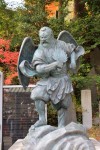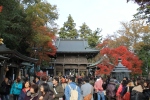Last month, I posted pictures of the autumn foliage at Mount Togakushi, which rises to 1904m (6246). For the lower Mount Takao though, the maples were peaking this past week. Only an hour west of Shinjuku on the train, I decided to head for the hills.
Not only were the colors beautiful, but the religious landscape of Mount Takao is fascinating as well. Dotted with statues and shrines devoted to an assortment of buddhas, bodhisattvas, gongen and fabled priests, Takoasan’s vibrant mix of practices and beliefs (mostly Shingon Buddhist and Shugendō) is on full display as one hikes up the peak. Here are some images from the mountain.
- This is the traditional entrance to the mountain. Its now known as the Trail 1 (1号線) and takes you along the major temples and shrines of the mountain. Prepare for crowds on weekends and during autumn foliage. The sign reads, [the temple of] Yakuoin of Mount Takao.
- Sitting opposite the sign is Fudōin 不動院, the entrance temple to the mountain.
- A shrine for Jinben daibosatsu 神変大菩薩. Jinben is the deified En no Gyōja, the semi-legendary seventh century founder of Shugendō.
- A mountain bodhisattva.
- Iizuna gongen, the main deity of Takaosan, stands in the center, attended by his tengu retinue. Iizuna comes originally from Mt. Iizuna of the Togakushi range in Nagano Prefecture, though also has roots back to the Indian deity, Dakini. Under Japan’s complex system of honji suijaku 本字垂迹, whereby a powerful buddha or bodhisattva appears as a local god, Iizuna likewise appears as the local manifestation of a disguised, greater being. According to the mountain’s origin account (engi), Iizuna first appeared in the dream of a 14th century Shingon monk who had come from the Kyoto temple of Daigoin 醍醐院. At Takaosan, Iizuna is believed to assist humans in the form of the god, Fudō myōō (indicative of the sword, rope and flames), who likewise appears as the cosmic buddha, Dainichi 大日. This puts him in the unusual position of appearing as an appearance (Fudō) of no less than Dainichi, who is supposed to encompass all aspects of the cosmos (an existential pickle to then have a local manifestation). That aside, one can find statues of all three, as well as Iizuna’s retinue, along the traditional route up the mountain.
- In 1903, a Shingon priest had just finished the 88 temple henro 遍路 (circuit) of Shikoku. Inspired, he established a miniature circuit on Takoasan, which he marked with 88 small buddhas along the way. Here is a small statue of Dainichi as one of them. They all look identical but have different titles inscribed.
- Daitengu 大天狗, one of Iizuna’s attendants/protectors. The long nose is characteristic of most tengu, as are the wings (though only for certain types of tengu). He is cloaked in the garb of a yamabushi (practitioner of Shugendō), whose mysterious mountain existence sometimes gave way to rumors of being part tengu.
- Kotengu 小天狗, Iizuna’s other attendant, takes a menacing pose opposite Daitengu.
- Crowds passing through the entrance gate (Niōmon 仁王門) to the main temple of Yakuōin 薬王院. (This was on a Thursday, so beware of weekends.)
- Yakuōin’s Main Hall. Visitors light incense and fan the blessings of its smoke toward themselves as they pass by.
- A carved dragon by the entrance of the Main Hall.
- Kukai 空海, sitting atop a lotus blossom, bears the features of a buddha in the image. Given the mountain’s Shingon heritage, numerous statues of the school’s founder can be seen along the paths.
- Inari 稲荷 foxes are placed by patrons on rocks beside a small Inari shrine. Inari shrines are ubiquitous across the country but especially relevant here, where the fox was often paired with the animal-like Iizuna in popular ritual.
- A Shingon priest performs a goma fire ritual inside Fudōin 不動院, a small goma hall behind the main temple complex.
- The view from the summit. On a clear day, Mount Fuji can be seen off to the right.
- Wet leaves along the path down.
- A takigyō 滝行 (waterfall practice) site devoted to the Shugendō deity, Fudō myōō, near the base of the mountain (trail number 6). Practitioners of Shugendō chant and perform mūdra under the freezing waterfall. The site is off-limits except to practitioners during designated ritual times.
Access: Mount Takao can be easily reached from Tokyo (Shinjuku) via the regional train system. Click here for details on transportation and hikes. The station, Takaosanguchi, places one about ten minutes’ walk from the entrance to the peak. There are lots of cool shops and eateries on the way to the base.
There are lots of trails, so choosing can be a little difficult. My suggestion: take numbers 1 or 2 in order to pass by all the temples and shrines on the way up. These courses more or less follow the traditional route up the mountain. For something off the beaten path that skips the crowds, opt for the Inarisan 稲荷山 course or number 6 (though its oddly closed to downhill traffic for certain seasons) on the way down. There’s also a cable car for slackers who want a ride halfway up ; )
Either way, for those in Tokyo looking for a bit of natural respite, Takao’s a must.
























